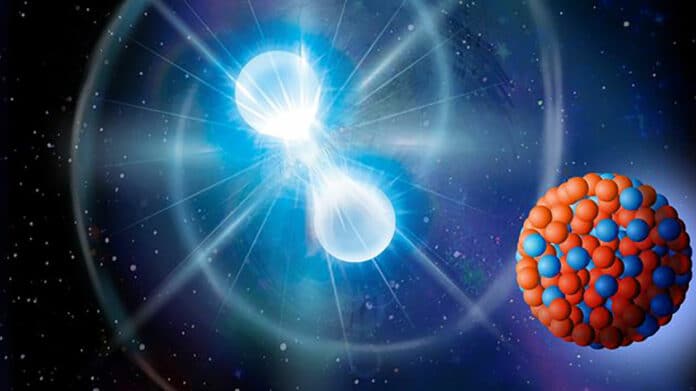The collision of neutron stars is thought to create precious metals such as gold and platinum. The characteristics of these stars remain a mystery, but the solution could be found in the lead atomic nucleus, one of the tiniest building blocks on Earth. It has proven challenging to unlock the secrets of the vital force which controls neutron star interiors in the atom’s nucleus.
A new study from the Chalmers University of Technology, Sweden, can offer the answers. Using a computer model, the study presents a breakthrough in calculating the atomic nucleus of the heavy and stable element lead.
The model, developed with colleagues in North America and England, now shows the way forward. It enables high-precision predictions of properties for the isotope* lead-208 and its so-called ‘neutron skin.’
Even though a neutron star’s size is many kilometers larger than an atomic nucleus, its properties are generally governed by the same physics. The common denominator is the vital force that binds protons and neutrons to one another in an atomic nucleus. A neutron star is likewise prevented from collapsing by the same force. Despite being a fundamental component in the cosmos, the vital force is challenging to account for in computer models, especially when it comes to heavy, neutron-rich atomic nuclei like lead. As a result, the researchers’ complex calculations have left them struggling with many unresolved issues.
To understand how the strong force works in neutron-rich matter, scientists need meaningful comparisons between theory and experiment, the observations made in laboratories and with telescopes, and reliable theoretical simulations.
Andreas Ekström, Associate Professor at the Department of Physics at Chalmers and one of the main authors of the article, said, “Our breakthrough means that we have been able to carry out such calculations for the heaviest stable element-lead.”
The researchers merged theories with pre-existing data from experimental studies to create a new computational model. After that, a statistical method previously used to simulate the potential spread of the coronavirus was combined with complex calculations.
It is now possible to assess several strong force hypotheses using the new model for lead. Predictions for various atomic nuclei, from the weakest to the heaviest, can also be made using the model.
The 126 neutrons that make up an atomic nucleus create the atom’s exterior covering, or skin. The properties of the vital force are related to the thickness of the skin. Understanding the vital force’s operation, both in atomic nuclei and neutron stars, can be improved by anticipating the thickness of the neutron skin.
Research leader Christian Forssén, Professor at the Department of Physics at Chalmers, said, “We predict that the neutron skin is surprisingly thin, which can provide new insights into the force between the neutrons. A groundbreaking aspect of our model is that it provides predictions and can assess theoretical margins of error. This is crucial for being able to make scientific progress.”
“The breakthrough could lead to more precise models of, for example, neutron stars and increased knowledge of how these are formed.”
“The goal for us is to understand better how the strong force behaves in neutron stars and atomic nuclei. It takes the research one step closer to understanding how, for example, gold and other elements could be created in neutron stars– and at the end of the day, it is about understanding the universe.”
Journal Reference:
- Hu, B., Jiang, W., Miyagi, T. et al. Ab initio predictions link the neutron skin of 208Pb to nuclear forces. Nat. Phys. 18, 1196–1200 (2022). DOI: 10.1038/s41567-022-01715-8
